Wijk aan Zee Recap Part II
February 08, 2010 • General
Greetings to everyone around the world. Fortunately, it is sunny outside and most of us in the United States have recovered from SUPER SUNDAY! I know most people here probably would prefer chess to football (including Dave the webmaster, who is a Colts fan!) but I found the game to be extremely exciting. Having grown up in New York, I always was impressed by Sean Payton’s ability as the defensive coordinator for the Giants. Overall, I felt that New Orleans won due to the many interesting and simply brilliant decisions including the onside kick to start the second half. Although I was pulling for Peyton Manning and the Colts due to the people I know in Indy, New Orleans was simply the better team last night. Alas, another football season has come and gone, but there’s always next year for my Titans! Now back to chess…
Round 6: Ivanchuk-Nakamura
In the sixth round, I kept facing strong players as I was Black against GM Vasily Ivanchuk from Ukraine. Of the modern day players, I think my style most resembles his in that we are the two players who play just about any opening depending on which side of the bed we wake up on! At the same time, he is also one of the few players who can beat anyone which makes him dangerous. Having beaten Vasily in the rapid finals of Cap D’Agde in 2008, I knew that he’d be angling for revenge this time around. Therefore, I decided to play the Slav against his 1.d4 (a minor surprise!).
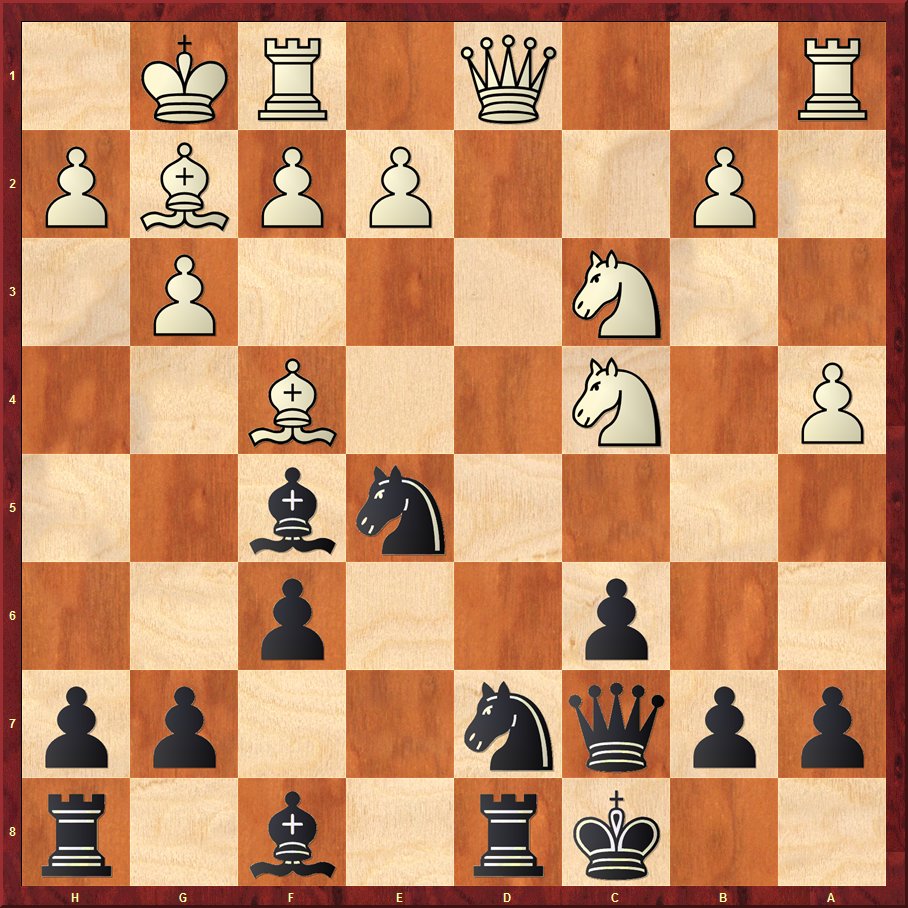
This was really the first surprise of the game as I have played the fairly obscure 12…0-0-0. In other top encounters, 12…Be6 was preferred. During the game, I was feeling fairly confident as I had reached this position in my analysis prior to the game. At the board, though, I began thinking to myself what if he plays 13.a5? My suspicions were confirmed shortly afterwards when he played it! Fortunately, it was not hard for me to come up with the right plan as there aren’t a whole lot of logical moves. As such, I was able to force a repitition after 13…Nc5 14.Qe1 Nb3 15.Ra4 Nc5 16.Ra1 Nb3 leading to a draw. During the tournament, there were many people who asked how could I take a quick draw as it runs contrary to my style. The answer is quite simple in that if either Vasily or I chose to play on, we’d be worse. Sometimes, being practical and taking quick draws makes sense. Obviously, I had the foresight to do that here, but not against Karjakin when it mattered, D’oh!
Round 7: Nakamura-Shirov
After the draw with Ivanchuk, I was on a very respectable 4/6 while Shirov was blazing on 5.5/6 and in the clear lead by a half point. Although neither Kris nor I came into the tournament with expectations of me winning, we decided that I should definitely go all out for glory in this game. Since I went into the game with this mindset I decided to play 1.e4 as I felt Shirov would create complications no matter which opening I chose. Despite the fact I felt Alexei made a mistake in choosing the sicilian against me, I still must respect his decision to stay true to his style despite the tournament situation. The opening was very much a seesaw battle as I felt after 15 moves I was simply better. To his credit, it was around this time that Alexei used a lot of time and came up with the right idea of exchanging his dark square bishop. Over the course of the next few moves I got careless giving away any advantage I had. The key point occurred in the following position after 19.Bf3.
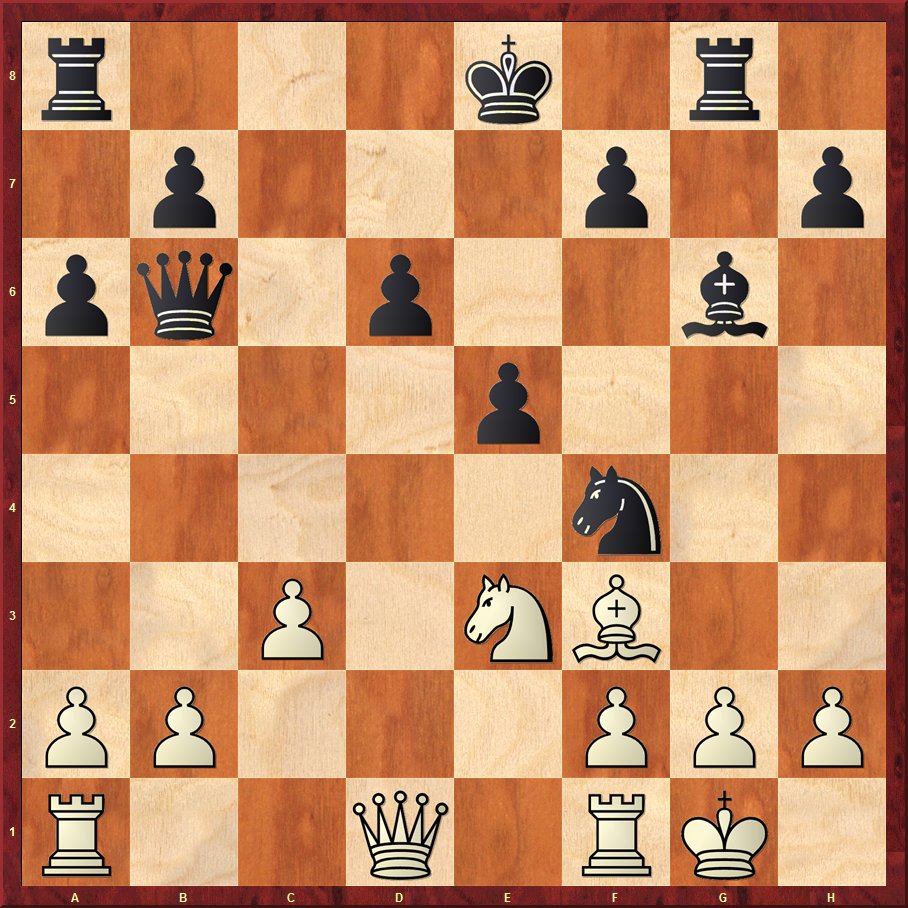
In this position, I was not quite sure about the evaluation. However, I correctly judged that Alexei would go for a tactical solution in the position. In chess, there are certain positions where intuitively you feel like there has to be a way to win material. As it turns out, Black is probably better after the simple 19…Rd8, but Alexei like myself spent most of his time trying to come up with something tactical which was incorrect. After 19…Nh3 20.Kh1 Nxf2 21.Rxf2 Qxe3 22.Bxb7 I think Alexei overlooked 22…Qxf2 23.Qxd6 with a crushing threat of Bc6 mate. Once this key opportunity was missed, the position became difficult to play for Black. Although any computer program would probably draw (beat us weak humans) it without too much trouble, it was still incredibly unpleasant to play. This coupled with Alexei’s impending time pressure proved to be too much as in the time pressure, he cracked and I won! Although it was not fate to win the tournament, I knew that after this win that this event was a success regardless of how I ended.
Round 8: Kramnik-Nakamura
In the eighth round, I got Black against the 14th World Champion, Vladimir Kramnik. Coming off such a high following the previous round, I knew this would be an extremely difficult task. However, as a good friend said once before, you play the games since the underdog can come out ahead. Thanks to a certain girl, I took the French Canadien phrase, “C’est de la biere” (It’s a beer which basically means it’s a piece of cake) and simply tried to relax and enjoy the game. There are some days when we all just play badly. This day proved to be one of these as it got off to a bad start when I switched my opening choice at the last minute and decided to play the Dutch. In the game, we went into the Leningrad and Vladimir played the interesting 8.Rb1 line. Pretty much immediately I went off the beaten path as I started pushing pawns like a total patzer. Eventually we reached the first of two key positions after 19.Bxe3.
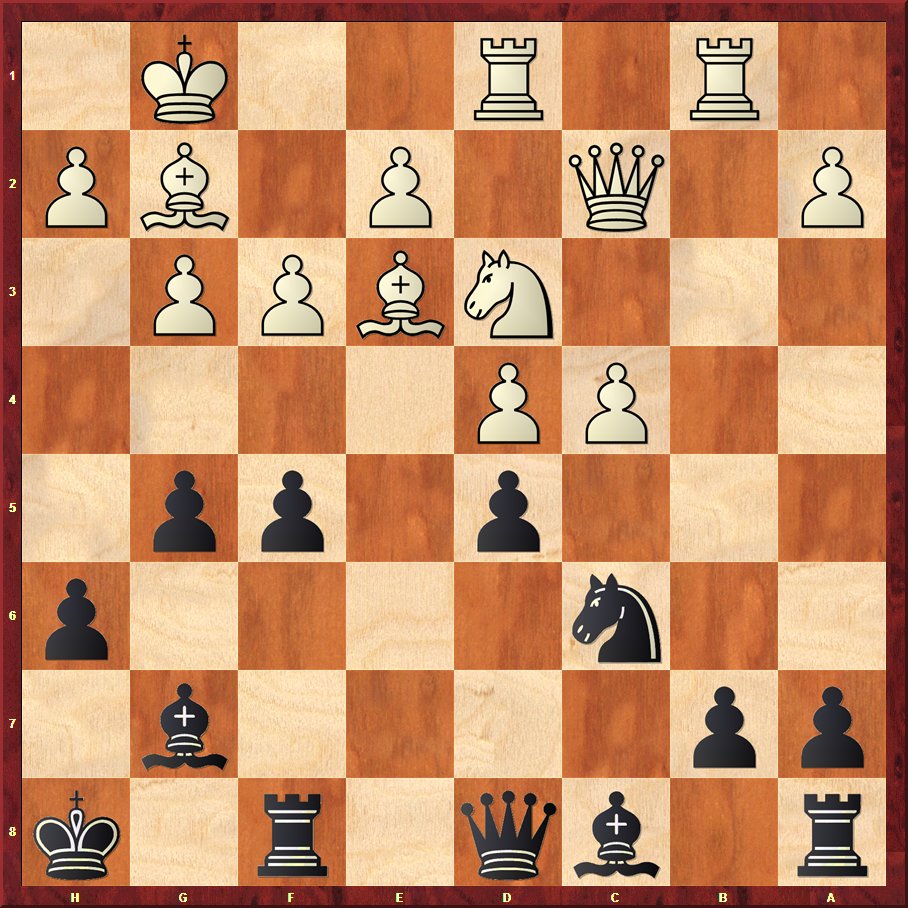
In this position, I calculated 19…Qe7 and thought it made the most sense only to have a finger fehler and play 19…Nxd4. In reality, the move I played was correct but it screwed with my mind. Normally this is not a problem, but almost immediately after I played Nxd4, I started thinking, “hmm, wait, why did I not go Qe7??” After 20.Qc1 White would had a big advantage, but when you have lingering doubts during a game, it can affect you adversely. After a series of more or less forced moves we reached the second and final chance I had to save the game.
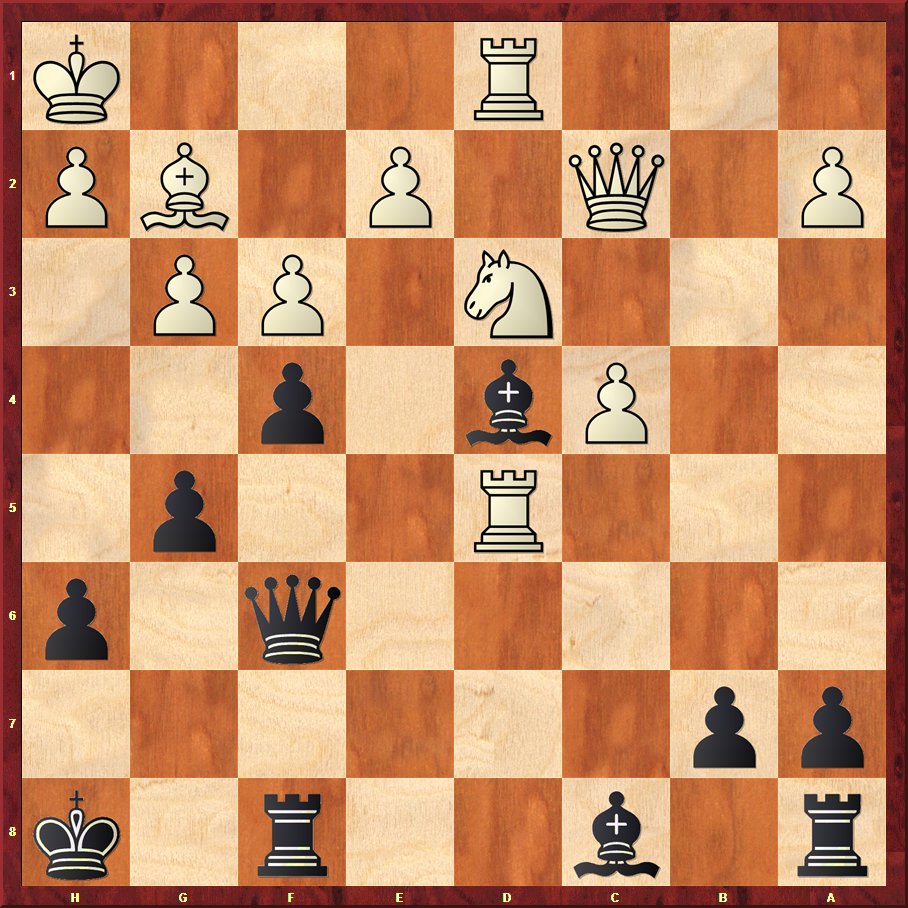
In this position, Vladimir had just played 23.Rxd5. During the game, I only considered playing either 23….Bf5 or 23…Be6. As it turns out, our silicon friend thinks I am probably fine if I trade on g3 and then follow it up with Be6. However, during the game I fully intended to play Bf5 only to then start considering Be6. For some bizarre reason, I calculated 23…Be6 24.Rxd4 Qxd4 25.Nxf4 as a variation. Then, once I played 23…Be6 I immediately spotted the obvious 24.Nxf4. After this secondary blunder, the game was beyond hope and I duly lost.
This certainly was not a positive development as far as the tournament was concerned. On the positive side, it was only after the second blunder that I was losing. Nevertheless, I played badly and got punished. Alas, I only join the likes of people such as Kasparov who have gotten crushed by Kramnik. Being in such good company cannot be something to complain about!
Round 9: Nakamura-Karjakin
In the ninth round, I had White against former child prodigy, Sergey Karjakin formerly of Ukraine and now playing for Russia.Sergey and I are certainly no strangers as we have played several times in the past. Before I discuss the game, I would just like to point out that despite my sometimes controversial style and comments in the past, I have not intentionally insulted someone in public. In many ways, I found Sergey’s comments on chesspro to be incredibly disgusting and insulting. One can only hope that people grow up much like I have since my younger days.
In this game, I chose to play 1.d4 as I was coming off a brutal loss and wanted to play a bit safer. Sergey surprised me almost from the start by choosing the Nimzo Indian over his preferred Slav. The opening was a bit unusual in that I had two doubled pawns on the c file. However, the diagonals certainly made up for it.
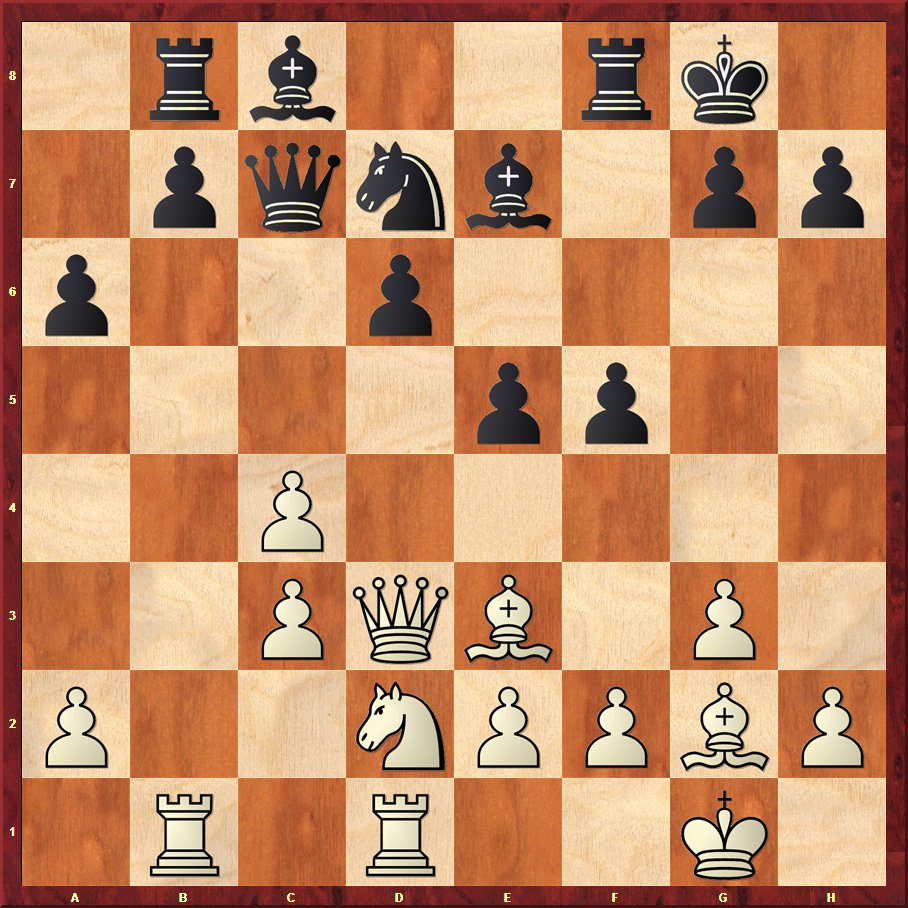
In this important position, we had repeated with 17.Ba7 Ra8 18.Be3 Rb8. Much like in my game against Ivanchuk, I had a serious decision to make here. Should I take a relatively quick draw and get ready for the following round or try to press on. Here, I thought for some time and decided to play despite the messy position and not having a lot of time. Although this was objectively fine since the position was not any worse for me, from a general standpoint it was simply wrong. The rest of the game, I did not play particularly inspiringly, and I eventually overpressed in time pressure making a horrible blunder. There really was not much positive news from this game as I once again just did not play very accurately. However, with four rounds still left, I felt that it would be possible to put up a solid plus score if i returned to form. The one big drawback at this point was that during this game, I started feeling a bit tired and hallucinating during this and the subsequent games. Alas, when you play two major tournaments back to back eventually all the energy being spent will catch up.
Stay tuned for the third and final installment from north of the border!
Cheers,
Hikaru
2.8.10



Thanks for the Recap and analysis 🙂 . What puzzles me is an article here : blogs.techrepublic.com.com/geekend/?p=4211
For sure preparation whitout computers is not imaginable these days , but memorize 500-1000 movs , no way 😉 :
“Kris and Hikaru go over the report together, and Hikaru memorizes the 500-1000 moves that it includes, reciting it back to Kris without looking at the board to ensure that he has all the information in his head when he goes into a game. And that’s when computational power ends and human skill and talent take over.”
Even full games can be decided from preparation sure , but the opponent can choose a different line , as he has the same resources , does preparation gives you an advantage at Wijk ?
Yes, preparation is 55% of the work, this is what Kasparov has to say about preparation, which can not be confused with memorization. This is a recap when Kasparov was preparing for the 1984 and 1985 match against Karpov when Karpov was in in best form and young. Also Kasparov mention how he use Chessbase 10 with Magnus Carlsen
After that, we compiled a list of chess openings that were most likely to occur in the match, with a preference to variations leading to complicated and at times intricate positions. From here onwards, we began concrete chess opening preparations. This is a most important part of the preparation for any important chess match, and our work here included studying a number of variations for both the black and white sides of the same chess opening. All these work, which were the result of hours and hours of prolonged brainstorming together with my highly-qualified trainers throughout a five-month period, helped me greatly in the critical situation, which arose soon after the start of the match.
Preparation of the opening with Carlsen:
You can’t prepare without the computer specially chessbase 10, since you must be constantly updated with all the improvements in the modern-day game of chess. Now that I am working with Magnus, Alexander Shakarov and I will always go to TWIC and we will look at the regular issues, just to see the games – all the relevant ones. You have to follow, you have to update your database and you have to be aware about the improvements. And, those are just general tournaments. As for, big tournaments like Moscow, I am always following them. You can’t be behind. It’s not like 20 years ago, when you knew you could benefit from a game that was played somewhere where nobody else saw it. Today, in a week, or in 24 hours, or live, people can see all these games. So that’s why you have to be very creative, because everybody have access to the same information. Your creativity is more important, because you have to process these games and invent something new.
C H E S S B A B E 10
Fast-and-easy preparation for any specific player
Display of games and moves with statistics in tree style
Openings references include an overview of common variations
Openings books with instantaneous display of replies
Yes, preparation is 55% of the work, this is what Kasparov has to say about preparation, which can not be confused with memorization. This is a recap when Kasparov was preparing for the 1984 and 1985 match against Karpov when Karpov was in in best form and young. Also Kasparov mention how he use Chessbase 10 with Magnus Carlsen
After that, we compiled a list of chess openings that were most likely to occur in the match, with a preference to variations leading to complicated and at times intricate positions. From here onwards, we began concrete chess opening preparations. This is a most important part of the preparation for any important chess match, and our work here included studying a number of variations for both the black and white sides of the same chess opening. All these work, which were the result of hours and hours of prolonged brainstorming together with my highly-qualified trainers throughout a five-month period, helped me greatly in the critical situation, which arose soon after the start of the match.
Preparation of the opening with Carlsen:
You can’t prepare without the computer specially chessbase 10, since you must be constantly updated with all the improvements in the modern-day game of chess. Now that I am working with Magnus, Alexander Shakarov and I will always go to TWIC and we will look at the regular issues, just to see the games – all the relevant ones. You have to follow, you have to update your database and you have to be aware about the improvements. And, those are just general tournaments. As for, big tournaments like Moscow, I am always following them. You can’t be behind. It’s not like 20 years ago, when you knew you could benefit from a game that was played somewhere where nobody else saw it. Today, in a week, or in 24 hours, or live, people can see all these games. So that’s why you have to be very creative, because everybody have access to the same information. Your creativity is more important, because you have to process these games and invent something new.
C H E S S B A B E 10
Fast-and-easy preparation for any specific player
Display of games and moves with statistics in tree style
Openings references include an overview of common variations
Openings books with instantaneous display of replies
why is not carlsen writing that in his blog gary? why you need to put that here?
jezz, this carlsen fans.
Hi everyone!
First of all, of course, congratulations to Hikaru for his performance in Netherlands, I followed his games and, as with Shirov, found his games the most risking, exciting, and enjoyable among the tournament participants.
I post this time because I would like to know from anyone, or Hikaru himself if he is that kind, what was he referring to, in the annotations to Karjakin´s game, when he said : “…I have not intentionally insulted someone in public. In many ways, I found Sergey’s comments on chesspro to be incredibly disgusting and insulting”, as I tried to look for it and couldn’t find anything about his own statements, and the chesspro website is almost all in Russian.
Have a good day to all, and I am looking forward for part 3 of the Wijk ann Zee´s Hikaru´s report.
Best regards from Argentina,
Adolfo
(reply to Adolfo)
I looked at the ChessPro site and I can’t tell what Hikaru is referring to. I did find an old interview with Karjakin at http://www.chesspro.ru/inter/karjakin.shtml, which appears to date from about 2005, after Hikaru trounced Karjakin in a 6-game match. The interviewer seems totally shocked that Karjakin, a self-anointed future world champion, could have possibly lost to a nobody like Nakamura. He asks Karjakin, “Didn’t you want to punish him for such a computerlike, artificial style?” Karjakin blames his loss in the first two games on the time difference, and says that he was winning in almost every game. However, if this is the interview Hikaru is referring to, I don’t quite see what he is so upset about. Yes, Karjakin comes off sounding conceited, but it’s more the interviewer’s fault for asking him questions like that.